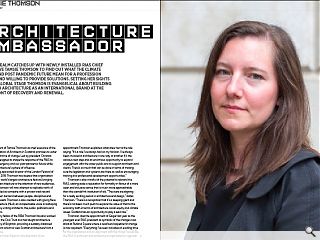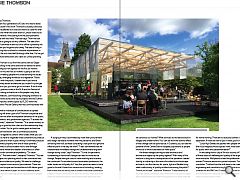Tamsie Thomson: Architecture Amnassador
22 Jul 2021
Urban Realm catches up with newly installed RIAS chief executive Tamsie Thomson to find out what the climate crisis and post pandemic future mean for a profession ready and willing to provide solutions. Setting her sights on the global stage Thomson is evangelical about building scottish architecture as an international brand at the forefront of recovery and renewal.
The appointment of Tamsie Thomson as chief executive of the Royal Incorporation of Architects in Scotland promises to usher in a new programme of change. Led by president Christina Gaiger this is designed to shape the response of the RIAS to the climate emergency and our post-pandemic future while expanding architecture’s sphere of influence.
Since being appointed director of the London Festival of Architecture in 2016 Thomson has steered that organisation to become the world’s largest architecture festival, bringing architects and architecture to the attention of new audiences, a feat which Thomson will now attempt to replicate north of the border. Hailed as someone with a proven track record in breaking down barriers between people, disciplines and competing interests Thomson is also credited with giving New London Architecture (NLA) an indispensable voice in reshaping the alpha city by uniting architects, the public, politicians and business leaders.
An honorary fellow of the RIBA Thomson has also worked for Shelter and the Civic Trust and has taught architecture at the University of Brighton, providing a suitably distanced background from which to view Scottish architecture from a fresh perspective.
Speaking to Urban Realm in the aftermath of her appointment Thomson explained what drew her to the role saying: “It’s a role I’ve always had on my horizon. I’ve always been involved in architecture in one way or another. It’s the obvious next step and an enormous opportunity to expand engagement with the wider public and to support architects and clients. There’s so much that can be done in terms of making sure the legislation and systems are there as well as encouraging training and professional development opportunities.”
Thomson is also mindful of the potential to rebrand the RIAS, casting aside a reputation for formality in favour of a more open and inclusive stance that is much more approachable than the scandal-hit institution of old. “The stars are aligning for a really exciting period in architecture and design,” states Thomson. “There’s a recognition that it’s a sleeping giant and there’s not been much push to explore the value of that to the economy both in terms of architecture, social equity and climate issues. Scotland has an opportunity to play a lead role.”
Thomson cites the appointment of Gaiger last year as the youngest ever RIAS president as symbolic of the changes now afoot at Rutland Square where a newfound appetite for change is now apparent. “Everything I’ve seen indicates an exciting time for the organisation and an alignment with the things I would like the RIAS in particular and architectural organisations in general to do,” observes Thomson.
Coming from four generations of Scots who had to leave because they couldn’t find work Thomson is acutely conscious of the need to recalibrate our cities and towns to cater for their residents at a time when the brain drain to London looks to be switching into reverse. Articulating how the post-pandemic economy aligns with this need Thomson says: “How we look at infrastructure is going to be very different. The idea of an hour and a half commute in and out of an office is probably not as attractive now you’ve gone cold turkey. The idea of living in town and walking kids to school is a massive improvement in your quality of life and cities like Edinburgh offer that. You’ve got a density of cultural attractions and clean air, unlike sprawling London.”
Crucially, Thomson is cut from the same cloth as Gaiger and both are pulling in the same direction to realise the same ambitions. Setting out her agenda for the first six months Gaiger says: “For me, the first six months is going to be a lot of learning and meeting people and understanding the issues around diversity, emerging architects and legislation. I’ll also be doing more with the public. I believe that if you have a message to convey about architecture you mustn’t try and get people to come to you, you must go out to them. A lot of what I’ve done in my previous roles at the NLA and the Festival of Architecture is taking architecture to the people using shop window presentations, commissioning emerging architects to do summer benches across the city to projects like the Dulwich Pavilion.” (a temporary events space by IF_DO within the grounds of Dulwich Picture Gallery that was commissioned with LFA.)
Engaging with a multitude of constituencies to spread RIAS messaging will draw upon all of Thomson’s expertise and experience, given the often incompatible demands of the public, commercial interests, and government agencies. “It echoes the role of the architect”, observes Thomson. “To a certain extent, an architect is only as good as their client and the relationship they have with each other. You’ve got to create great architecture within a financial framework with a commercial outcome working within a legislative context which states what you can and can’t do. You have to negotiate those constraints to produce good architecture and when it goes wrong it’s normally because it’s failed to connect properly with one of those partners.”
This disconnect is all too evident from a look through any planning portal where the idealism of architects is often at loggerheads with commercial expediency. “Or value-engineered out”. That awful term”, interjects Thomson. “You see so much that goes into planning which is then contracted into something of less architectural quality. We need to challenge some of the accepted norms around procurement. There are lots of ways it can be open and accessible and still deliver good results on time and within budget. It’s about breaking down some of those fears and opening up the opportunity to people in different ways.”
A bulging in-tray is dominated by more than procurement and design standards however with the pandemic and Brexit still taking their toll, do these competing crises point to a genuine inflexion point in the way we work? “I read somewhere that we overestimate immediate change and underestimate long term change during crises”, says Thomson. “To me, the pandemic is interesting in how small changes can lead to more radical change. People have got used to home working and business has continued. For architecture and associated professions, the order books are still pretty full. Very few practices seem to have gone to the wall. Aside from issues around schooling, working from home and not being part of a team it has been positive for people. If we all commute 50% less than we did, what does that mean for carbon emissions and infrastructure plans and how we construct our homes? What services do we need to build in villages and smaller towns? You can see how the domino effect of that change can be quite radical. In Scotland, you can see the potential of the Central Belt to dissipate populations as people move out to more rural areas for more space.”
Are these changes serving to raise architects and architecture higher up the policy agenda? With many of the medium to long-term consequences of the pandemic related directly or indirectly to the work of architects and landscape architects, can the clamour for space, light and flexible living seed a rediscovery of quality architecture among the public? “I think you’re right”, responds Thomson. “I keep thinking of the high-density developer flats where the living space is open plan to the kitchen and what those spaces must have been like for home working. There are no acoustic barriers or physical separation. If there are two of you in there, you’re in trouble.
“Local High Streets are packed with people who are using their local neighbourhood spaces more, what does that mean for public realm and pedestrianisation?”
In relocating from a city of 9m to a country of 5m many of these issues of wellbeing and quality of life ought to be more tractable. Well placed to lead the profession from July onward Thomson arrives at a pivotal moment. Thomson concludes: “Scotland has the skills base to be a really interesting engineering and manufacturing hub. There is so much potential for the RIAS and Scottish architecture in building an international brand because the opportunities are there. We just need to shout about it more.”




